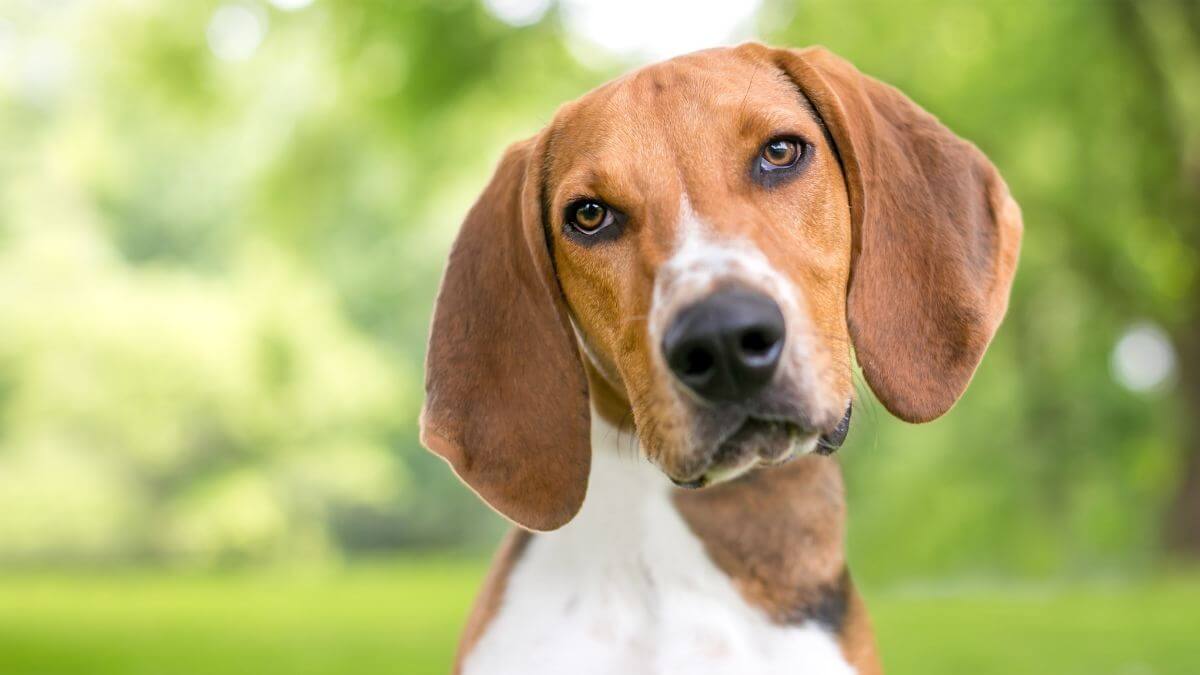
Home » Judging the American Foxhound

This article was originally published in Showsight Magazine, April 2013 issue.
The first widely recognized Standard for an “ideal” American Foxhound was drawn up in 1894. The men writing the standard represented the different strains of Foxhounds—thus, compromise was necessary. The seven men were Roger D. Williams, W. S. Walker, W. C. Goodman, Hagan, W. Wade, H. C. Trigg, and Dr. A. C. Heffenger. Until that time, the American hounds were judged under the English Foxhound Standard.
The very first thing that an American Foxhound should exude is CLASS, and that is conveyed through SYMMETRY. At a meeting of the club held on January 18, 1905, it was voted to call for that type of hound which shows “class,” meaning the highest percentage of Conformation needed in Foxhounds for field use in America.
“The high type of the American Foxhound considered ideal by the American Foxhound Club has a physique and characteristics all its own.”
This is still true and should be the basis for judging the hound today.
Symmetry, as used in hounds, means the following: the form of the hound must be harmonious throughout. He must show his blood quality and hound character in every respect and movement.
When viewing the hound in profile, check for BALANCE—the parts must be smooth and harmonious. The hound should be in hard muscle and well-conditioned. Always remember, outward quality denotes the nervous energy within. With the hound well-proportioned, symmetrical, CHEERFUL, in good condition, and moving true and lightly with springiness to his gait, we can study the details and fine points.
The head should be balanced with the body. The muzzle should be about the same length as the distance from the stop to the inion. You do not want a short head. The upper lip, when viewed from the side, should make a right angle. This is more important in the dog hound; you always want a strong, masculine head on a dog hound. The bitch should be feminine. The eyes, large, soft, and dark, must have an intelligent expression.
The ears are the crowning glory. They should reach the nose, but don’t scalp a hound in the process of measuring the length. Most important is the placement of the ears—they should be just below a line horizontal from the corner of the eye back. The ears should hang as draped folds like rich velvet. The ears should NEVER, NEVER APPEAR LIKE A SHINGLE TACKED TO THE HEAD.
The neck should be long and spring upward and forward. While running, the neck is well extended. Throatiness is like a dowager’s double chin: most undesirable. Always check for this.
The topline is NOT LEVEL—there should be a slight rise over the loin. This should never be confused with a roached or “wheel” back, which is most undesirable. The underline of the hound is a graceful curve from the deep chest, which gives room for lungs and heart. Remember, the hound needs lung space for the endurance required to hunt for 4 to 8 hours or longer.
The stern, or tail, is the finish of the topline. It should never be stuck upright on the back. Rather, the stern leaves in a horizontal curve upward. The amount of the curve may differ, but the tail should never be carried over the back. The tail is strong and tapers uniformly from the root to the tip. It can differ in the amount of hair, but as long as it is not longhaired like a Setter or a rat tail, it is fine. A shelf just behind the tail is desirable.
The legs are straight from elbow to pastern but must have sufficient bone—never weedy, but NEVER large and overdone. Strength and substance are key—not lumber. A Foxhound must be able to negotiate timber, woven wire fences, and walk the top rail or stone walls. This is achievable because of their fox-like foot. It is not a hare foot and not a cat foot. The fox-like foot allows a hound to hunt in rocks and bound over fields.
You want a good thick pad and well-arched toes. The foot of the Foxhound should be like that of the fox: strong and closely knit, but with sufficiently flexible toes to give spring. With this flexibility, they will not go lame. As an example, I once observed a young Trigg bitch come home after three days and three nights of hunting bear in the mountains of Virginia—tired, walking on tiptoes and sore, but not lame. WITHOUT PROPER FEET, YOU DO NOT HAVE AN AMERICAN FOXHOUND.
Never worry about size. A small or large hound is acceptable as long as you have balance and symmetry. Never, ever judge on COLOR; a good hound cannot be a bad color.
Our standard does not mention gait; however, it is most important and follows SYMMETRY. THE GAIT IS THAT OF A WORKING HOUND. Good reach and drive are essential. The hind legs must be strong—never weak and never straight. A good hound must be light on its feet, with great reach and drive. This is achievable only if the hound is symmetrical in conformation. Without this, speed and good movement become mechanically impossible.
What was spoken of over a century ago regarding how to become a good American Foxhound judge is still true today:
“Read, study, and observe closely for twenty years—and then ask.”